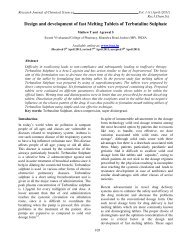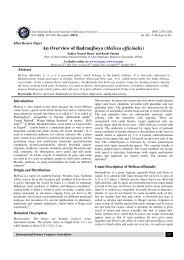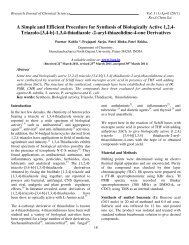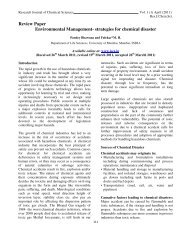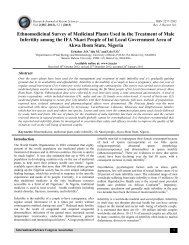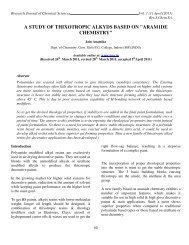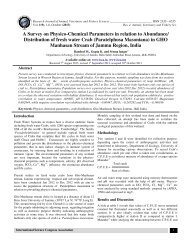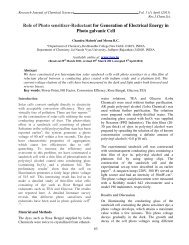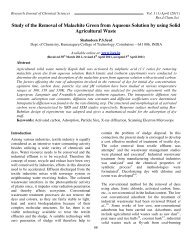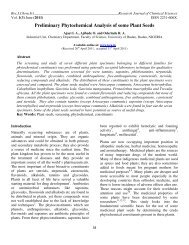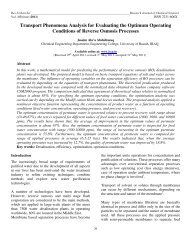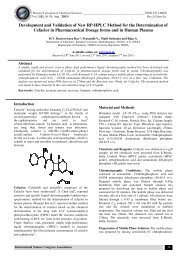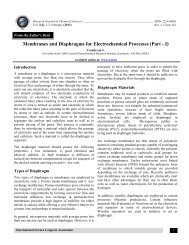(acrylates) and their Copolymer as Viscosity Modifiers - ISCA
(acrylates) and their Copolymer as Viscosity Modifiers - ISCA
(acrylates) and their Copolymer as Viscosity Modifiers - ISCA
You also want an ePaper? Increase the reach of your titles
YUMPU automatically turns print PDFs into web optimized ePapers that Google loves.
Res.J.Chem.Sci.______________________________________________Research Journal of Chemical Sciences<br />
Vol. 1(3) June (2011) ISSN 2231-606X<br />
Evaluation of Poly (<strong>acrylates</strong>) <strong>and</strong> <strong>their</strong> <strong>Copolymer</strong> <strong>as</strong> <strong>Viscosity</strong> <strong>Modifiers</strong><br />
Abstract<br />
Ghosh Pranab, D<strong>as</strong> Tapan <strong>and</strong> D<strong>as</strong> Moumita<br />
Natural Product <strong>and</strong> Polymer Chemistry Laboratory<br />
Department of Chemistry, University of North Bengal, Darjeeling, 734013, INDIA<br />
Available online at: www.isca.in<br />
(Received 22 nd April 2011, accepted 3 rd May 2011)<br />
Homopolymers of decyl acrylate, dodecylacrylate <strong>and</strong> isodecylacrylate <strong>and</strong> copolymers of each of them<br />
with styrene were synthesized <strong>and</strong> characterized. Intrinsic viscosity <strong>and</strong> viscometric molecular weight of<br />
each of them were determined by using Huggins <strong>and</strong> Mark - Houwink equation respectively. <strong>Viscosity</strong><br />
index improver (VII) properties were tested with additive doped b<strong>as</strong>e oil in terms of viscosity index (VI)<br />
of the b<strong>as</strong>e oil – additive blends. VI values of the additive doped b<strong>as</strong>e oils depend on the nature of<br />
mineral b<strong>as</strong>e oils used <strong>and</strong> the type <strong>and</strong> concentration of VI improvers.<br />
Keywords: <strong>Viscosity</strong> index, b<strong>as</strong>e oils, blended oils, viscosity index improvers<br />
Introduction<br />
B<strong>as</strong>e fluids mineral oil generally cannot satisfy the<br />
requirements of high performance lubricants without<br />
using the benefit of modern additive technology.<br />
Additives are synthetic chemicals that can improve<br />
or add performances of lubricants. Some additives<br />
impart new <strong>and</strong> useful properties to the lubricant;<br />
some enhance properties already present, while some<br />
act to reduce the rate at which undesirable changes<br />
take place in the product during its service life. One<br />
of the important types of additive is viscosity index<br />
improvers commonly known <strong>as</strong> viscosity modifier 1 .<br />
<strong>Viscosity</strong> index improvers function by incre<strong>as</strong>ing the<br />
relative viscosity of oil more at high temperatures<br />
than at low temperatures 2-4 .Generally these result<br />
from the polymer changing its physical<br />
configuration with incre<strong>as</strong>ing temperature of the<br />
mixture. It is believed that the polymer molecule in<br />
solution exists <strong>as</strong> a r<strong>and</strong>om coil, which is swollen by<br />
the lube oil solvent. The volume of this molecule<br />
determines the viscosity incre<strong>as</strong>e. In cold oil the<br />
molecules of the polymer adopt a coiled form so that<br />
<strong>their</strong> effect on viscosity is minimized. In hot oil, the<br />
molecules tend to straighten out <strong>and</strong> the interaction<br />
between these long molecules, having greater<br />
volume <strong>and</strong> the oil produces a proportionally greater<br />
thickening effect which in turn raises the viscosity<br />
index (VI) of the oil. The viscosity index is an<br />
indicator of the change in viscosity <strong>as</strong> the<br />
temperature is changed. The higher the VI, the less<br />
the viscosity of an oil changes for a given<br />
temperature change.<br />
Some of the polymers generally used commercially<br />
<strong>as</strong> VII, <strong>and</strong> known to possess certain inherent<br />
advantages <strong>and</strong> disadvantages in performance, are- i)<br />
Poly isobutylene (PIBs), ii) Hydro-generated Styrene<br />
–isoprene copolymers, iii) Olefin copolymers<br />
(OCP); e.g. Ethylene- propylene copolymer, IV)<br />
Esters of styrene- Maleic anhydride copolymers <strong>and</strong><br />
v) Poly alkyl meth<strong>acrylates</strong> (PMA).<br />
In continuation of our activities towards the<br />
development of polymeric additives for lube oil 5<br />
recently we have synthesized some long chain poly<br />
<strong>acrylates</strong>, e.g. poly (decylacrylate), poly<br />
(dodecylacrylate), poly (isodecylacrylate) <strong>and</strong> also<br />
copolymer of each of them with styrene to see <strong>their</strong><br />
applicability <strong>as</strong> VI improver. The polymers were<br />
characterized <strong>and</strong> evaluated in lube oil for <strong>their</strong> VII<br />
properties.<br />
Material <strong>and</strong> Methods<br />
Esterification <strong>and</strong> polymerization: Esterification<br />
of acrylic acid with different alcohols, purification of<br />
18
Res.J.Chem.Sci.______________________________________________Research Journal of Chemical Sciences<br />
Vol. 1(3) June (2011) ISSN 2231-606X<br />
the prepared esters <strong>and</strong> subsequent polymerization<br />
(homo <strong>and</strong> copolymerization) were carried out<br />
following the procedure <strong>as</strong> reported in our earlier<br />
publications 6, 7 .<br />
Characterization: All the polymers were<br />
characterized on the b<strong>as</strong>is of spectral analysis (IR,<br />
NMR), thermo gravimetric analysis (TGA) <strong>and</strong> by<br />
viscometric method <strong>as</strong> reported in our earlier paper 8 .<br />
Determination of intrinsic viscosity <strong>and</strong><br />
viscometric molecular weight: Intrinsic viscosity<br />
<strong>and</strong> viscometric molecular weight (Table 1) were<br />
determined by using the experimental viscosity of<br />
the polymer solutions in Huggins (eq.1) <strong>and</strong> Mark<br />
Houwink – Sukurda equation (eq.2) respectively 6-8 .<br />
η<br />
Huggins (H) sp = [ η] k [ ] 2<br />
C<br />
C<br />
h<br />
+<br />
h<br />
η<br />
h<br />
(1)<br />
Where, C is m<strong>as</strong>s concentration.<br />
η sp = η r –1, specific viscosity<br />
η r = t/t 0 , relative viscosity or viscosity ratio (where t<br />
is time of flow of solution <strong>and</strong> t 0 is time of flow of<br />
pure solvent).<br />
[η] h = intrinsic viscosity, respective to Huggins<br />
equation, k h , Huggins coefficient<br />
According to Mark Houwink – Sukurda (eq. 2), the<br />
value of intrinsic viscosity changes with the<br />
molecular weight of the polymer in a solvent <strong>as</strong>:<br />
η = KM<br />
(2)<br />
[ ]<br />
a<br />
Where, [η], the intrinsic viscosity, can be calculate<br />
by using Huggins equation, parameter ‘K’ <strong>and</strong> ‘a’<br />
depends on the type of polymer, solvent <strong>and</strong><br />
temperature. For the viscosity – average molecular<br />
weight determination, the constants K = 0.00387<br />
dl/g <strong>and</strong> a = 0.725 were employed in Mark Houwink<br />
– Sukurda relation 7.8 .<br />
Determination of viscosity index (VI): The<br />
prepared polymers were tested for <strong>their</strong> effectiveness<br />
<strong>as</strong> viscosity index improvers in two different b<strong>as</strong>e<br />
oils (BO1 <strong>and</strong> BO2) according to ASTM D-7042<br />
method <strong>and</strong> also by using the method of viscosity<br />
index calculation reported in litersature 9 . In this<br />
respect, the kinematic viscosities of the oil, doped<br />
with different concentrations of the tested additives<br />
were determined at 40 o C <strong>and</strong> 100 o C.<br />
Different concentrations, ranging between 1-6%<br />
(wt/wt), were used to study the effect of<br />
concentration on VI of the lube oil.<br />
Results <strong>and</strong> Discussion<br />
Table 1 presents intrinsic viscosity <strong>and</strong> viscometric<br />
molecular weight. Intrinsic viscosity <strong>and</strong> molecular<br />
weight of the copolymers are always found higher<br />
than the respective homopolymers.<br />
The b<strong>as</strong>e oil properties are tabulated in table 2. The<br />
prepared polymers were tested for <strong>their</strong> effectiveness<br />
<strong>as</strong> viscosity index improvers for b<strong>as</strong>e oil (BO1 <strong>and</strong><br />
BO2) according to ASTM D-2270. In this respect,<br />
the kinematic viscosities of the oil doped with<br />
different concentrations of the tested additives were<br />
determined at 40 o C <strong>and</strong> 100 o C. The concentrations<br />
were ranging from 1% to 6%, which is used to study<br />
the effect of the additives concentration on VI of<br />
lube oil.<br />
It is clear from the VI data tabulated in table 3 to<br />
table 14 <strong>and</strong> the plots of VI vs concentration (Figure<br />
1 <strong>and</strong> Figure 2), that irrespective of the type of<br />
polymer (homo or copolymer) <strong>and</strong> nature of the b<strong>as</strong>e<br />
oil, VI values incre<strong>as</strong>es with the incre<strong>as</strong>e in additive<br />
concentration in the b<strong>as</strong>e oils studied. A critical<br />
observation of the VI values of the homopolymers<br />
indicated that better performance is obtained with<br />
the acrylate having greater chain length of the<br />
alcohols in the acrylate monomer. It is also observed<br />
that branching in the carbon chain of the alcohol<br />
detoriates its performance when used <strong>as</strong> a VII in the<br />
lube oil. Thus the chain length <strong>and</strong> its arrangements<br />
play a significant role when added in the lube oil to<br />
act <strong>as</strong> a VI. A possible explanation may be, <strong>as</strong> the<br />
temperature is raised, the lube oil viscosity gets<br />
decre<strong>as</strong>ed <strong>and</strong> <strong>as</strong> a result of that the polymer<br />
molecules get exp<strong>and</strong>ed due to the incre<strong>as</strong>e in the<br />
salvation power <strong>and</strong> the size of the micelle. This<br />
incre<strong>as</strong>e in micelle size counterbalanced the<br />
reduction of the viscosity of the lube oil <strong>and</strong> hence,<br />
19
Res.J.Chem.Sci.______________________________________________Research Journal of Chemical Sciences<br />
Vol. 1(3) June (2011) ISSN 2231-606X<br />
decre<strong>as</strong>es the change of viscosity with temperature<br />
of the mixture 10-11 .The incre<strong>as</strong>e in concentration of<br />
the polymer leads to an incre<strong>as</strong>e in the total volume<br />
of polymer micelles in the oil solution <strong>and</strong> thus<br />
exerting greater thickening effect <strong>and</strong> so <strong>as</strong> to VI<br />
properties.<br />
Conclusion<br />
Irrespective of the polymers (homo <strong>and</strong> copolymer)<br />
<strong>and</strong> nature of the b<strong>as</strong>e oils, VI values incre<strong>as</strong>es with<br />
the incre<strong>as</strong>e in additive concentration in the b<strong>as</strong>e oils<br />
studied.<br />
VI values of the homopolymers indicated that better<br />
performance is obtained with the acrylate having<br />
greater chain length of the alcohols in the acrylate<br />
monomer. Again, branching in the carbon chain of<br />
the alcohol deteriorates the performance of the<br />
acrylate when used <strong>as</strong> a VI improver in the lube oil.<br />
Thus, the chain length <strong>and</strong> its arrangements in the<br />
polymer of a viscosity modifier play a significant<br />
role when added in the lube oil to act <strong>as</strong> a VI<br />
improver.<br />
Acknowledgement<br />
Authors thank to UGC, New Delhi for financial<br />
support.<br />
References<br />
1. El-Gamel I.M., Ghuiba F.M., El- Batanoney<br />
M.H. <strong>and</strong> Gobiel S., Synthesis <strong>and</strong> evaluation of<br />
acrylate copolymers for improving flow<br />
properties of waxy crudes, J. Appl. Polym. Sci.,<br />
52, 9-19, (1994)<br />
2. Ford J.F. <strong>and</strong> Wood J.M., Phosphoramidates of<br />
Alpha-olefin Polymers, The British Petroleum<br />
Co. Limited, US Patent 3, 562, 16 (1971)<br />
3. Kapur G.S., Sarpal A.S., Mazumdar S. K. Jain,<br />
S. K., Sriv<strong>as</strong>tava S.P. <strong>and</strong> Bhatnagar A.K.,<br />
Structure performance relationships of viscosity<br />
index improvers : I micro structural<br />
determination of olefin copolymers by NMR<br />
spectroscopy, Lubr. Sci., 8(1), 49–60, (1995)<br />
4. Mohamed M.M., Hamdi H.A. <strong>and</strong> Mohamed F.<br />
E., Multifunctional viscosity index improvers, J.<br />
Chem. Technol. Biot., 60, 283–289 (1994)<br />
5. Akhmedov A.I., <strong>Copolymer</strong> of alkyl<br />
meth<strong>acrylates</strong> with styrene <strong>as</strong> V.I. improvers for<br />
lubricating oils. Chem. Tech. Fuels Oil, 30(1–2),<br />
34-37 (1994)<br />
6. Ghosh P., D<strong>as</strong> T. <strong>and</strong> N<strong>and</strong>i D., Synthesis<br />
characterization <strong>and</strong> viscosity studies of<br />
homopolymer of methyl methacrylate <strong>and</strong><br />
copolymer of methyl methacrylate <strong>and</strong> styrene,<br />
J. Soln. Chem., 40, 67-78 (2011)<br />
7. Ghosh P., D<strong>as</strong> T., N<strong>and</strong>i D., Karmakar G. <strong>and</strong><br />
M<strong>and</strong>al A., Synthesis <strong>and</strong> characterization of<br />
biodegradable polymer - used <strong>as</strong> pour point<br />
depressant. Int. J. Polym. Mater., 59, 1008-1017<br />
(2010)<br />
8. Ghosh P., D<strong>as</strong> M. <strong>and</strong> D<strong>as</strong> T., Synthesis<br />
characterization <strong>and</strong> viscosity studies of acrylate<br />
b<strong>as</strong>ed homo <strong>and</strong> copolymers, Res. J. Chem.<br />
Environ., 14(4), 26-31 (2010)<br />
9. Dean E.W. <strong>and</strong> Davis G.H.B., <strong>Viscosity</strong><br />
variations of oils with temperature, Chem. Met.<br />
Eng., 36(3), 618-619 (1929)<br />
10. Eckert R.J.A. <strong>and</strong> Covey D.F., Development of<br />
the field of hydrogenated diene copolymers <strong>as</strong><br />
viscosity index improver, Lubr. Sci., 1, 65(1988).<br />
11. N<strong>as</strong>sar A.M., Synthesis <strong>and</strong> Evaluation of<br />
<strong>Viscosity</strong> Index Improvers <strong>and</strong> Pour Point<br />
Depressant for Lube Oil, Petrol. Sci. Technol.,<br />
26(5), 523-531 (2008)<br />
20
Res.J.Chem.Sci.______________________________________________Research Journal of Chemical Sciences<br />
Vol. 1(2) May (2011) ISSN 2231-606X<br />
Table-1: Intrinsic viscosity <strong>and</strong> viscometric molecular weight of prepared polymer. S-1<br />
poly(decylacrylate), S-2 poly(dodecylacrylate), S-3 poly(isodecylacrylate), S-4 copolymer of decylacrylate<br />
with styrene, S-5 copolymer of dodecylacrylate with styrene <strong>and</strong> S-6 copolymer of isodecylacrylate with<br />
styrene<br />
Samples [η] h M h<br />
S-1 4.34 16051<br />
S-2 4.059 14,672<br />
S-3 3.774 13,270<br />
S-4 2.677 8255<br />
S-5 2.621 8,026<br />
S-6 2.737 8,520<br />
B<strong>as</strong>e oil properties<br />
Table-2: B<strong>as</strong>e oil properties<br />
BO1<br />
21<br />
B<strong>as</strong>e oils<br />
BO2<br />
<strong>Viscosity</strong> at 40 0 C in cSt 7.202 23.609<br />
<strong>Viscosity</strong> at 100 0 C in cSt 1.872 3.951<br />
Cloud point, 0 C -8 -10<br />
Pour point, 0 C -3 -6<br />
Table-3: VI values for poly (decyl acrylate) (S-1) in BO1 oil<br />
Solution Conc. (wt %) Kinematic <strong>Viscosity</strong> at 40 o C Kinematic <strong>Viscosity</strong> at100 o C VI<br />
0 7.202 1.872 87.00<br />
1 7.262 1.891 90.48<br />
2 7.298 1.901 91.93<br />
3 7.345 1.914 93.66<br />
4 7.403 1.928 95.08<br />
5 7.440 1.946 98.98<br />
6 7.479 1.962 101.95<br />
Table-4: VI values for poly (decyl acrylate) (S-1) in BO2 oil<br />
Solution Conc. (wt %) Kinematic <strong>Viscosity</strong> at 40 o C Kinematic <strong>Viscosity</strong> at VI<br />
100 o C<br />
0 23.609 3.951 81.68<br />
1 23.982 4.032 85.09<br />
2 24.070 4.080 88.41<br />
3 24.125 4.099 89.30<br />
4 24.232 4.157 92.80<br />
5 24.303 4.189 94.80<br />
6 24.393 4.248 98.15
Res.J.Chem.Sci.______________________________________________Research Journal of Chemical Sciences<br />
Vol. 1(2) May (2011) ISSN 2231-606X<br />
Table-5: VI values for poly (isodecyl acrylate) (S-2) in BO1 oil<br />
Solution Conc. (wt %) Kinematic <strong>Viscosity</strong> at 40 o C Kinematic <strong>Viscosity</strong> at 100 o C VI<br />
0 7.202 1.872 87.00<br />
1 7.302 1.903 92.51<br />
2 7.340 1.915 94.52<br />
3 7.382 1.925 95.36<br />
4 7.424 1.945 99.52<br />
5 7.460 1.959 101.95<br />
6 7.502 1.975 104.58<br />
Table-6: VI values for poly (isodecyl acrylate) (S-2) in BO2 oil<br />
Solution Conc. (wt %) Kinematic <strong>Viscosity</strong> at 40 o C Kinematic <strong>Viscosity</strong> at 100 o C VI<br />
0 23.609 3.951 81.68<br />
1 24.026 4.060 87.21<br />
2 24.083 4.087 88.71<br />
3 24.156 4.116 90.48<br />
4 24.248 4.164 93.38<br />
5 24.335 4.223 96.77<br />
6 24.402 4.284 100.34<br />
Table-7: VI values for poly (dodecylacrylate ) (S-3) in BO1 oil<br />
Solution Conc. (wt %) Kinematic <strong>Viscosity</strong> at 40 o C Kinematic <strong>Viscosity</strong> at 100 o C VI<br />
0 7.202 1.872 87.00<br />
1 7.357 1.918 94.52<br />
2 7.422 1.938 97.60<br />
3 7.474 1.953 99.52<br />
4 7.546 1.977 103.00<br />
5 7.603 1.993 104.58<br />
6 7.682 2.022 108.68<br />
Table-8: VI values for poly (dodecyl acrylate) (S-3) in BO2 oil<br />
Solution Conc. (wt %) Kinematic <strong>Viscosity</strong> at 40 o C Kinematic <strong>Viscosity</strong> at 100 o C VI<br />
0 23.609 3.951 81.68<br />
1 24.070 4.097 89.59<br />
2 24.147 4.149 93.09<br />
22
Res.J.Chem.Sci.______________________________________________Research Journal of Chemical Sciences<br />
Vol. 1(2) May (2011) ISSN 2231-606X<br />
3 24.236 4.217 97.32<br />
4 24.311 4.270 100.34<br />
5 24.371 4.310 102.48<br />
6 24.419 4.338 103.80<br />
Table-9: VI values for copolymer of DA+ styrene (S-4) in BO1 oil<br />
Solution Conc. (wt %) Kinematic <strong>Viscosity</strong> at 40 o C Kinematic <strong>Viscosity</strong> at 100 o C VI<br />
0 7.202 1.872 87.00<br />
1 7.246 1.882 88.11<br />
2 7.310 1.900 90.77<br />
3 7.385 1.914 91.35<br />
4 7.451 1.932 93.66<br />
5 7.529 1.952 95.93<br />
6 7.610 1.972 98.15<br />
Table-10: VI values for copolymer of DA+ styrene (S-4) in BO2 oil<br />
Solution Conc. (wt %) Kinematic <strong>Viscosity</strong> at 40 o C Kinematic <strong>Viscosity</strong> at 100 o C VI<br />
0 23.609 3.951 81.68<br />
1 23.899 4.017 84.78<br />
2 23.986 4.054 86.91<br />
3 24.092 4.092 89.00<br />
4 24.159 4.125 91.06<br />
5 24.267 4.174 93.95<br />
6 24.357 4.214 95.93<br />
Table-11: VI values for copolymer of IDA+ styrene (S-5) in BO1 oil<br />
Solution Conc. (wt %) Kinematic <strong>Viscosity</strong> at 40 o C Kinematic <strong>Viscosity</strong> at 100 o C VI<br />
0 7.202 1.872 87.00<br />
1 7.284 1.893 89.89<br />
2 7.334 1.905 91.35<br />
3 7.410 1.923 93.09<br />
4 7.498 1.949 96.77<br />
23
Res.J.Chem.Sci.______________________________________________Research Journal of Chemical Sciences<br />
Vol. 1(2) May (2011) ISSN 2231-606X<br />
5 7.606 1.976 99.52<br />
6 7.673 1.991 100.61<br />
Table-12: VI values for copolymer of IDA+ styrene (S-5) in BO2 oil<br />
Solution Conc. (wt %) Kinematic <strong>Viscosity</strong> at 40 o C Kinematic <strong>Viscosity</strong> at 100 o C VI<br />
0 23.609 3.951 81.68<br />
1 23.949 4.040 86.00<br />
2 24.020 4.067 87.81<br />
3 24.084 4.088 89.00<br />
4 24.158 4.124 91.06<br />
5 24.234 4.166 93.66<br />
6 24.342 4.214 96.21<br />
Table-13: VI values for copolymer of DDA+ styrene (S-6) in BO1 oil<br />
Solution Conc. (wt %) Kinematic <strong>Viscosity</strong> at 40 o C Kinematic <strong>Viscosity</strong> at 100 o C VI<br />
0 7.202 1.872 87.00<br />
1 7.339 1.906 91.35<br />
2 7.422 1.925 93.09<br />
3 7.510 1.951 96.77<br />
4 7.608 1.965 95.93<br />
5 7.684 1.992 100.34<br />
6 7.738 2.014 104.06<br />
Table-14: VI values for copolymer of DDA + styrene (S-6) in BO2 oil<br />
Solution Conc. (wt %) Kinematic <strong>Viscosity</strong> at 40 o C Kinematic <strong>Viscosity</strong> at 100 o C VI<br />
0 23.609 3.951 81.68<br />
1 23.987 4.050 86.61<br />
2 24.080 4.087 88.71<br />
3 24.171 4.128 91.35<br />
4 24.250 4.165 93.38<br />
5 24.364 4.215 95.93<br />
6 24.478 4.275 99.25<br />
24
Res.J.Chem.Sci.______________________________________________Research Journal of Chemical Sciences<br />
Vol. 1(2) May (2011) ISSN 2231-606X<br />
120<br />
100<br />
VI<br />
80<br />
60<br />
40<br />
S-1<br />
S-2<br />
S-3<br />
S-4<br />
S-5<br />
S-6<br />
20<br />
0<br />
-1 0 1 2 3 4 5 6 7<br />
Concentration wt%<br />
Figure-1: Plot of <strong>Viscosity</strong> Index (VI) vs polymer concentration in BO1 b<strong>as</strong>e oil, where S-1 Poly(decyl<br />
acrylate), S-2 Poly(isodecyl acrylate), S-3 Poly(dodecyl acrylate), S-4 copolymer of DA+ styrene, S-5<br />
copolymer of IDA+ styrene, S-6 copolymer of DDA+ styrene<br />
120<br />
100<br />
VI<br />
80<br />
60<br />
40<br />
S-1<br />
S-2<br />
S-3<br />
S-4<br />
S-5<br />
S-6<br />
20<br />
0<br />
-1 0 1 2 3 4 5 6 7<br />
Concentration wt%<br />
Figure-2: Plot of <strong>Viscosity</strong> Index (VI) vs polymer concentration in BO2 b<strong>as</strong>e oil, where S-1 Poly(decyl<br />
acrylate), S-2 Poly(isodecyl acrylate), S-3 Poly(dodecyl acrylate), S-4 copolymer of DA+ styrene, S-5<br />
copolymer of IDA+ styrene, S-6 copolymer of DDA+ styrene<br />
25



